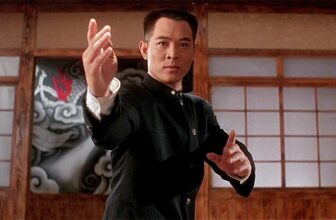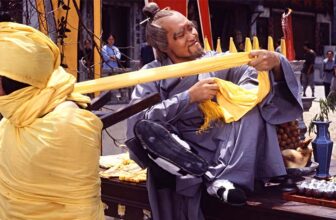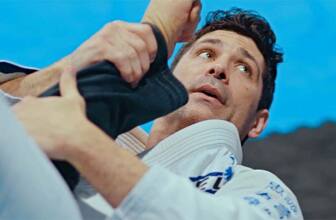
How is it even possible? One of the most acclaimed animated shows ever made spawning one of the most detested films of the 21st century, and under the direction of a filmmaker who was at one point pegged by Newsweek as “The Next Spielberg”, no less. Four years after its release, M. Night Shymalan’s “The Last Airbender” is infamous as the bête noire of the show’s colossal fan base, and can be found on countless lists of the Worst Movies Ever Made. While that last accolade of dishonor is a little on the hyperbolic side (it doesn’t even come close to the sheer awfulness of your average “Scary Movie”, and each film in that sorry excuse for a comedy series is curiously absent from the list)! With such enormous potential for greatness, “The Last Airbender” is still is a phenomenal letdown for martial arts lovers and fans of the series alike.
Trailer
Cast
American Taekwondo exponent Noah Ringer makes his film debut in the role of Aang, the last surviving airbender who must assume the mantle of the Avatar in order to restore balance to the world. Nicola Peltz and Jackson Rathbone take on the roles of Aang’s trusted allies in his quest, Katara and Sokka. Meanwhile, Dev Patel, fresh from his rise to fame from “Slumdog Millionaire”, steps into the role of their nemesis (Prince Zuko) who is bound and determined to capture the Avatar, with a nemesis of his own in the form of Commander Zhao, played by Aasif Mandvi of “The Daily Show” fame. The casting is one of the major elephants in the room with the film, given that the race of almost every character great and small has been drastically altered. Theoretically, this kind of decision shouldn’t be enough to destroy a movie. However, the entire world of “Avatar” was specifically inspired by and meant to be representative of Asian cultures, which makes their inexplicable live-action makeover all but impossible to ignore.
Plot
In the world of the Four Nations, the highest form of martial arts is embodied by the bending arts – the ability to manipulate the elements of Water, Earth, Fire, and Air. Only the Avatar, the spirit of light tasked with maintaining balance in the world, is capable of mastering all of the elements. According to his cycle of reincarnation, he was to be reborn into the Air Nomads. However, the imperialist Fire Nation, which spent the past century set on a conquering the world, have long since wiped out the Air Nomads, and the Avatar is believed to be no more. That is, until two teenaged siblings of the Southern Water Tribe, Katara and Sokka, discover an airbender named Aang, who had been encased in ice for over a century. Their discovery is soon followed by the arrival of the Fire Prince Zuko, exiled from the Fire Nation by his father and only permitted to return on the condition that he capture the Avatar. After Aang escapes Zuko’s clutches, Katara and Sokka join with him to make their way through the Earth Kingdom and to the Northern Water Tribe, where Aang and Katara will be able to master their waterbending skills and Aang will attempt to put a stop to the Fire Nation’s conquest of the Four Nations.
Action
A good deal of the problems in “The Last Airbender” can be attributed to the fact that the film is simply too short. In the span of ninety six minutes without credits, the film attempts to encompass all twenty episodes of the first season, or “Book One”, of the show, each episode averaging about 23 minutes long. If that sounds like an exercise in futility, it most certainly is, especially given how much the film aspires to duplicate the feel of an epic saga that the show embodied. If you’ve not seen the show, you need not worry about getting lost, as the film goes out of its way to fill in every last blank of what’s happening. It’s truly stunning how much of the film consists of characters explaining what just happened, both on and off-screen, and what it all means in excrutiating detail – a problem that could have been mitigated or excised entirely by simply making the film longer. It’s for that very reason that every “Harry Potter” and “Lord of the Rings” movie pushes it well-past the two-hour mark, even if more than a few entries of both series arguably overstay their welcome. There isn’t an “Avatar” fan in the world who would protest giving the same window to “The Last Airbender”, and by not going that route, the film ends up almost completely incapable of equaling the power and intensity of its source material in the eyes of its followers.
As for the casual filmgoer unfamiliar with the series looking for a jumping on point, or martial arts fans looking to see a more superhuman style of action, frankly the airbending seen in “Man of Tai Chi” comes closer to truly realizing the bending arts in live-action. Anyone who believed that the bending seen in the teaser trailer was representative of what the film had in store for its viewers will be sorely disappointed. The same goes for the film’s introductory sequence depicting practitioners of each of the bending arts displaying their skills before a red curtain, perfectly mimicking the lead-in to the show. In each case, the bending depicted took the approach of the show, where a character’s movements directly correlate to how the element is used – a big, sweeping motion used for circular attacks, a thrusting punch or kick used for linear movements, and various combinations thereof. Once the action gets started, however, the bending largely consists of characters simply waving their arms around until water or fire is deployed. Worse still, characters frequently spend what feels like an eternity getting their attack together, usually with it amounting to a fraction of the often god-like power the bending arts exhibited in the show, such as in the infamous “Pebble Dance” scene (sidenote – not very wise of the Fire Nation to imprison earthbenders outdoors). The viewer gets a rare glimpse of what could have been thanks to a great tracking shot showing Aang and a character known as the Blue Spirit fighting off Fire Nation troops side-by-side as they attempt to break the Avatar from captivity. By that point, the film will probably have tried the patience of many viewers by the fact that it’s the third time Aang has been kidnapped before the forty-five minute mark (another side effect of so drastically condensing twenty episodes). Perhaps nowhere else is the film’s poorly executed bending action seen than when Aang uses his waterbending to create a tidal wave to ward off a Fire Nation assault on the Northern Water Tribe. It basically amounts to Aang entering the “Avatar State” and performing a Tai Chi form while the wave slowly grows larger and larger – none of his movements correspond to what the wave does, nor does the wave itself seem to logically follow from anything our hero is doing. In this moment, we see “The Last Airbender” indulging in the greatest sin any martial arts action sequence can commit – the choreography on display is SO dance-like that it’s impossible for it to be believable as a fight scene.
Summary
If the “The Last Airbender” could be summarized in two words, it would be “squandered potential”. In the film’s vain effort to cram 20 episodes into an hour and a half, the viewer is forced to suffer through a constant deluge of characters explaining everything to them. Even worse, the poor execution of the bending arts, coupled with how badly the film is miscast, leaves it more resembling a subpar cosplay rather than a live-action version of such an acclaimed animated series. While there are far more deserving candidates for the Worst Movies Ever Made list, “The Last Airbender” made a wise move in shortening its title, as it is simply not worthy of the title of “Avatar”. Somebody PLEASE reboot this!
Trivia
- Dante Basco, who voiced Prince Zuko on the show, wanted to portray his character in the film, but as he was in his thirties at that point, he was deemed too old to play the 16-year old Zuko.
- The film was originally meant to have the same title as the show, “Avatar: The Last Airbender”. However, after James Cameron’s “Avatar” was released, the title was changed to simply “The Last Airbender” to avoid confusion.
- Seychelle Gabrielle portrays Princess Yue of the Northern Water Tribe in the film. She would later go on to provide the voice of the character Asami Sato in “The Legend of Korra”, the sequel series to “Avatar”.





